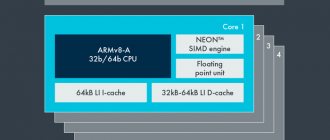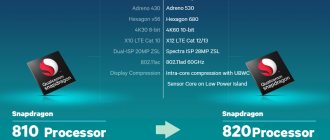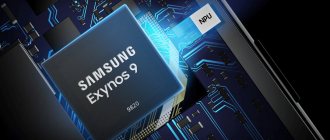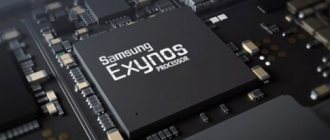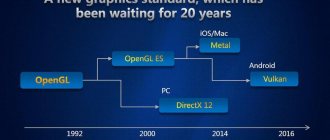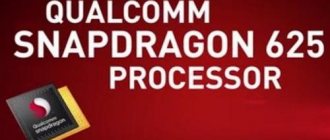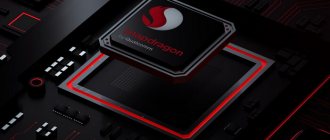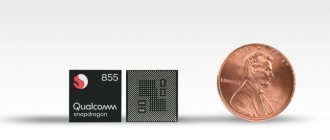Perhaps in 2020, Snapdragon processors are the most popular in the mobile device market: even companies that produce proprietary chipsets (Samsung and Huawei) sometimes install Qualcomm developments in their devices. Now there are a great variety of Snapdragon processor models on the market, among which it is easy to get lost. The rule “the higher the numerical index of a chipset, the cooler it is” really works when choosing the best chipset from Qualcomm, but not always. In addition, sometimes a more expensive model is practically no different from its “younger brother,” but devices based on it are much more expensive. In this article we will name the best representatives of each of the Snapdragon model series, describe the features of all series and the chipsets themselves.
Telegram channel of the creator of Trashbox about technology
What really matters in processors
In this article, we will not compare absolutely all technical characteristics of processors, since most of them are not important when choosing mobile devices: for example, information about the maximum camera resolution supported by the chipset or the ability to work with LPDDR4X memory will not help a person in any way when choosing a gadget (since the buyer purchases a smartphone or tablet with a camera and memory already installed, and not a computer where, if desired, any components can be replaced - even if the processor installed in the mobile device supports the best components, this is absolutely unimportant).
Characteristics of processors that you should pay attention to when purchasing a device:
- Technical process: chipset manufacturing technology, characterized by the resolution of the equipment used in the production of processors. Simply put, the fewer nanometers (nm), the better: cores created using the 7 nm process are more economical and more productive than their 10 nm counterparts, all other characteristics being equal.
- Core Clock Speed: Shows the number of operations performed per second and is measured in Hertz (Hz). The higher it is, the more productive the processor cores are.
- Number of cores: the more cores, the less the chipset is overloaded - all thanks to the better ability to distribute processes across multiple cores.
- Number and composition of clusters: to increase the energy efficiency of processors, cores with the same performance are installed in separate clusters. This allows you to separate productive cores from economical ones, so that resource-intensive tasks are performed only by “powerful” cores, and simple tasks are performed exclusively by low-performance cores. Almost all processors are built in a dual-cluster format, but in the Snapdragon 855, Qualcomm has resorted to technology with three clusters: in addition to productive and economical cores, the chipset contains medium-power cores. In theory, the more clusters, the more economical the processor.
- Graphics accelerator: This is an integrated video card in a smartphone, installed on the same board as the processor. Unfortunately, Qualcomm rarely shares the features of its Adreno series video accelerators, so the technical characteristics of some of them are unknown. What is clear is that the higher the numerical index of the GPU, the better the hardware.
- Digital Signal Processor (DSP): is a chipset that processes signals from various sensors of mobile devices in real time. It is much “weaker” than the central processor, but its performance is sufficient to perform its function. If DSP were not used, the sensor readings would be processed by the main processor, spending too much energy on non-resource-intensive tasks. Qualcomm doesn't reveal the specs of its Hexagon series DSPs, but we can safely assume that the higher the number, the better.
Snapdragon 8xx - flagship models
| Characteristics | Snapdragon 855 (2018) | Snapdragon 845 (2017) | Snapdragon 835 (2016) | Snapdragon 821 (2016) | Snapdragon 820 (2015) |
| Technical process | 7 nm | 10 nm (LPP) | 10 nm (LPE) | 14 nm | 14 nm |
| Cores | 1x2.84 GHz (Cortex-A76) 3x2.42 GHz (Cortex-A76) 4x1.8 GHz (Cortex-A55) | 4x2.8 GHz (Cortex-A75) 4x1.7 GHz (Cortex-A55) | 4x2.45 GHz (Cortex-A73) 4x1.9 GHz (Cortex-A53) | 2x2.4 GHz 2x1.6 GHz | 2×2.2 GHz 2×1.6 GHz |
| Graphics accelerator | Adreno 640 | Adreno 630 | Adreno 540 | Adreno 530 | Adreno 530 |
| Digital Signal Processor | Hexagon 690 | Hexagon 685 | Hexagon 682 | Hexagon 680 | Hexagon 680 |
Qualcomm demonstrates all its developments over the past year in its flagship processors. That is why the models in this series are sometimes significantly different from their predecessors. However, this does not always happen. For example, the Snapdragon 855 is significantly superior to the 845 model, since the new product uses a three-cluster format, is created using an advanced technological process and has an improved graphics accelerator and digital signal processor.
But the Snapdragon 845 did not receive fundamental changes compared to the Snapdragon 835 in terms of CPU performance, but its graphics accelerator was significantly improved (at least according to official statements).
We do not recommend considering smartphones based on Snapdragon 821 and 820 in 2020, since these chipsets are already quite outdated: the old process technology and four cores are not suitable for modern games and programs. In addition, for the price of devices with these processors, it is better to purchase modern sub-flagship smartphones or middle-class gadgets, which we will discuss below.
Popular smartphones with Snapdragon 855 processor:
- Xiaomi Mi 9 / Mi 9 TE
- Samsung Galaxy S10 / S10+ / S10e
Popular smartphones with Snapdragon 845 processor:
- Xiaomi Mi 8 / Mi 8 EE / Mi 8 Pro
- Xiaomi Pocophone F1
- Xiaomi Mi MIX 3
- Samsung Galaxy S9/S9+
- Samsung Galaxy Note 9
- OnePlus 6/6T
- Google Pixel 3/3 XL
- Nokia 9 PureView
Popular smartphones with Snapdragon 835 processor:
- Samsung Galaxy S8/S8+
- Samsung Galaxy Note 8
- OnePlus 5/5T
- Google Pixel 2/2 XL
Showcase
You can close this annoying message by clicking on the cross in the corner PHOTOGRAPHY MASTER Huawei P30 Pro is a new word in mobile photography. Use your smartphone to get a better view of nature: enjoy the beauty of the night sky, watch birds flying high in the clouds, or examine the smallest details of crystals.
ENJOYING COLOR Inspired by the beauty of the sky, Huawei P30 Pro evokes the rays of light piercing the clouds. Plunge into the blue of a clear sky and enjoy the beauty of the mysterious Northern Lights. IMPRESSIVE CAMERA SYSTEM The Leica quad-lens camera lets you capture the world in all its glory. The unique camera system includes a telephoto lens, a 40 MP super sensitive lens, a 20 MP ultra wide-angle lens and a Huawei TOF (Time of Flight) lens. Capture the best moments in your life with a Leica camera.
ZOOM UP TO THE UNREACHABLE The new periscope telephoto lens lets you zoom in on details without losing quality. Discover the beauty of unattainable objects with a 10x hybrid zoom and a 40 MP main camera with AI-powered color correction and image stabilization. Now you can photograph the Moon as if it were in front of your eyes.
MORE BRIGHT MOMENTS To ensure unrivaled image brightness, Huawei has decided to change the color gamut from RGB to RYB. Thanks to Huawei's spectral sensor, the powerful Kirin 980 processor and a self-developed algorithm, photos are 40% brighter and more detailed (compared to the Huawei P20 Pro smartphone).
ALL THE SHADES OF THE NIGHT Let the beauty of the night unfold with a camera with ISO 409600 sensitivity. Use the Huawei P30 Pro smartphone to capture a romantic evening with candles or fireflies circling the trees. Even complete darkness will not prevent you from getting a high-quality photo. PROFESSIONAL PORTRAIT SHOTS Huawei's camera and Intelligent Image Stabilization let you accurately measure depth of field to highlight your subject while blurring the background. The bokeh effect in photographs will become your calling card.
ALWAYS IN FOCUS AI-powered HDR+ improves the quality of your photos by analyzing multiple backlit and dimly lit photos and combining the best shots into one. Shooting in this mode balances lighting and color so your face is always in focus.
Snapdragon 7xx - sub-flagship models
| Characteristics | Snapdragon 730G (2019) | Snapdragon 730 (2019) | Snapdragon 712 (2019) | Snapdragon 710 (2018) |
| Technical process | 8 nm | 8 nm | 10 nm | 10 nm |
| Cores | 2x2.2 GHz (Cortex-A76) 6x1.8 GHz (Cortex-A55) | 2x2.2 GHz (Cortex-A76) 6x1.8 GHz (Cortex-A55) | 2x2.3 GHz (Cortex-A75) 6x1.7 GHz (Cortex-A55) | 2x2.2 GHz (Cortex-A75) 6x1.7 GHz (Cortex-A55) |
| Graphics accelerator | Adreno 618 | Adreno 618 | Adreno 616 | Adreno 616 |
| Digital Signal Processor | Hexagon 688 | Hexagon 688 | Hexagon 685 | Hexagon 685 |
Processors in this series are designed for sub-flagship smartphones, which require decent performance, but do not require various features of flagship models (such as support for ultra-high-resolution screens, sophisticated cameras, and the like).
The Snapdragon 730 differs from the version with the “G” prefix only in that the frequency of the latter’s video accelerator is slightly overclocked, making its graphics performance 15% higher. However, in practice, the difference between these chipsets is incredibly difficult to notice, so you can safely choose devices with the Snapdragon 730 (without overpaying for gadgets with the G version of the chipset).
The Snapdragon 712 and 710 processors are inferior to older models, and noticeably (judging by reviews and benchmarks). If you choose between gadgets based on these chipsets, then it’s certainly not worth paying extra money for the 0.1 GHz increased clock frequency of the two productive cores in the 712th “dragon”.
Popular smartphones with Snapdragon 730G processor: Not released yet.
Popular smartphones with Snapdragon 730 processor:
- Samsung Galaxy A80
Popular smartphones with Snapdragon 712 processor:
- Xiaomi Mi 9 SE
Popular smartphones with Snapdragon 710 processor:
- Samsung Galaxy A8s
- Xiaomi Mi 8SE
- OPPO RX17 Pro
- Nokia 8.1
- Meizu X8
- Meizu 16X
Snapdragon 6xx - average
| Characteristics | Snapdragon 675 (2018) | Snapdragon 670 (2018) | Snapdragon 665 (2019) | Snapdragon 660 (2017) | Snapdragon 636 (2017) |
| Technical process | 11 nm | 10 nm | 11 nm | 14 nm | 14 nm |
| Cores | 2x2.0 GHz (Cortex-A76) 6x1.7 GHz (Cortex-A55) | 2x2.0 GHz (Cortex-A75) 6x1.7 GHz (Cortex-A55) | 4x2.0 GHz (Cortex-A73) 4x1.8 GHz (Cortex-A53) | 4x2.2 GHz (Cortex-A73) 4x1.84 GHz (Cortex-A53) | 4x1.8 GHz (Cortex-A73) 4x1.6 GHz (Cortex-A53) |
| Graphics accelerator | Adreno 612 | Adreno 615 | Adreno 610 | Adreno 512 | Adreno 509 |
| Digital Signal Processor | Hexagon 685 | Hexagon 685 | Hexagon 686 | Hexagon 680 | Hexagon 680 |
Snapdragon 6xx series processors are designed for mid-range devices. Previously, these models were significantly inferior to their “big brothers”, but the Snapdragon 675, 670 and 665 released over the past two years have changed everything: these chipsets are not so much inferior in performance to models from the Snapdragon 7xx line. These three are quite similar in characteristics, and the 670 is even slightly ahead of the 675 in graphics and power consumption. As a result, when choosing a mobile device, you can safely consider gadgets on these three processors to be almost equal in performance.
Snapdragon 660 and 636 can already be called oldies, but manufacturers continue to release smartphones and tablets with these chipsets, since they still cope well with games and programs (even if not with the most demanding ones). The choice between these processors is simple: the 660 is an order of magnitude better than the 636 (but also more power hungry).
Popular smartphones with Snapdragon 675 processor:
- Samsung Galaxy A70
- Xiaomi Redmi Note 7 Pro
- Meizu Note 9
- Vivo V15 Pro
Popular smartphones with Snapdragon 670 processor:
- OPPO R17
- Vivo X23
- Vivo Z3
Popular smartphones with Snapdragon 665 processor: not yet presented.
Popular smartphones with Snapdragon 660 processor:
- Samsung Galaxy A9 (2018)
- Samsung Galaxy A6s
- Nokia 7 Plus
- Xiaomi Mi 8 Lite
- Xiaomi Mi Note 3
- Xiaomi Mi A2
- Meizu 15
Popular smartphones with Snapdragon 636 processor:
- Xiaomi Redmi Note 5
- Xiaomi Redmi Note 6 Pro
- Nokia 7.1
- Nokia 6.1 Plus
Qualcomm Snapdragon processors: what are they, how are they different, which one to choose?
Full handful
Today, there are more than a dozen current models of Qualcomm chips. Let's take a brief look at the technical characteristics of each of them.
Budget models:
- Snapdragon 439 and 450
- eight ARM Cortex-A53 processor cores, built-in Adreno 505/506 graphics accelerator, 12/14 nm process technology, average GeekBench score of 3300 / 3800 points, AnTuTu 59000 / 61000 (competitors to MediaTek Helio P22 and P35); - Snapdragon 632
– eight Kryo 250 cores (Qualcomm’s modified version of Cortex-A53), Adreno 506 graphics, 14 nm process technology, GeekBench 4500, AnTuTu 84000.
Mid-level models:
- Snapdragon 636 and 660
- four high-performance Kryo 260 Gold cores (analogous to Cortex A73) and four more energy-efficient Kryo 260 Silver (analogous to Cortex A53), Adreno 509/512 graphics, 14 nm process technology, GeekBench 5000 / 5500, AnTuTu 95000 / 110000 (competitors Helio P60 and P70, Exynos 7904); - Snapdragon 665
- four Kryo 260 Gold and four Kryo 260 Silver cores, Adreno 610 graphics, 11 nm process technology, GeekBench 5700, AnTuTu 115000 (competitors to Kirin 710, Exynos 9610);
- Snapdragon 670, 710 and 712
- two Kryo 360 Gold cores (Cortex A75) and six Kryo 360 Silver cores (analogous to Cortex A55), Adreno 615/616 graphics, 10 nm process technology, GeekBench 5700 / 5800 / 6000, AnTuTu 126000 / 137000 / 1 44000 ; - Snapdragon 675
- two Kryo 460 Gold cores (Cortex A76) and six Kryo 460 Silver (Cortex A55), Adreno 612 graphics, 11 nm process technology, GeekBench 6400, AnTuTu 130000 (competitors Helio G90, Kirin 810); - Snapdragon 730
- two Kryo 470 Gold (Cortex A76) and six Kryo 470 Silver (Cortex A55) cores, Adreno 618 graphics, 8 nm process technology, GeekBench 6800, AnTuTu 165000.
Flagship models:
- Snapdragon 845
– four Kryo 385 Gold cores (Qualcomm’s own architecture) and four Kryo 385 Silver cores, Adreno 630 graphics, 10 nm process technology, GeekBench 8800, AnTuTu 228000 (competitors to Kirin 980, Exynos 9820); - Snapdragon 855
- eight Kryo 485 cores (one super-powerful, three powerful and four energy-efficient), Adreno 640 graphics, 7 nm process technology, GeekBench 11000, AnTuTu 257000 (competitors Kirin 990, Exynos 9825).
Now let’s take a closer look at the architectural features and functionality of a typical mid-range Snapdragon 636 processor using the example of the Motorola Moto G7 Plus smartphone.
Motorola Moto G7 Plus 64 GB
A bright and contrasting IPS screen without PWM flicker, an eight-core processor, a main camera with a large sensor and optical stabilization, support for Wi-Fi 802.11ac and NFC, stereo speakers, separate slots for microSD and two SIMs, 27 W fast charging.
The battery capacity is only 3000 mAh.
Motorola Moto G7 Plus is one of the most functional Android smartphones in the price category under $300. Its IPS screen occupies as much as 81 percent of the front panel and has a neat teardrop-shaped cutout for the front camera. With a screen diagonal of 6.2 inches, the resolution is 2270x1080 pixels, which results in a cinematic aspect ratio of 19:9 and a high image density of 405 PPI. Fortunately, there is no unpleasant PWM flicker (PWM) like in competing smartphones with AMOLED displays.
The screen of the Moto G7 Plus is covered with tempered glass Gorilla Glass 3, and the back of the smartphone is made of the same material. At the back, in addition to the fingerprint scanner stylized as the Motorola logo, there are two more cameras: the main 16 MP with f/1.7 aperture and an additional 5 MP f/2.2 for measuring the depth of the frame. The main camera is built on a large Sony IMX519 photosensor (matrix size 1/2.6″, pixel size 1.22 microns) with Dual Pixel phase autofocus and OIS optical stabilization.
It is OIS, which eliminates hand tremors when walking, that most distinguishes this smartphone from its classmates and makes it an excellent solution for video shooting, including [email protected] But there is no ultra-wide-angle lens - this is already the prerogative of the Motorola One Action 128 GB model Price from 5 799 UAH. The front 12-megapixel camera takes very decent pictures, and all thanks to the also large photosensor (1/2.9″, 1.25 microns). For comparison, many competing smartphones use a similarly sized photosensor as the main camera, while the front camera is much simpler.
The brain of the Moto G7 Plus is an eight-core Qualcomm Snapdragon 636 processor with integrated Adreno 509 graphics. 4 GB of RAM and 64 GB of permanent flash memory. You can expand the internal storage using a microSD memory card, and there is a separate slot for it that does not interfere with the installation of two SIM cards. Pleasant bonuses include high-speed Internet via Wi-Fi 802.11ac and 4G-LTE, NFC contactless payments, loud stereo speakers, a double-sided USB-Type C cable and a transparent silicone case included.
As a result, the Motorola Moto G7 Plus is a moderately priced, but at the same time surprisingly balanced smartphone running a pure version of the Android OS with support for convenient Moto gestures (for example, turning on the camera or flashlight by shaking the smartphone). It is suitable for both demanding games and regular photo and video shooting. Don’t forget about the solid 27-watt included Turbo Charge power supply, which charges the smartphone by as much as 80 percent in just half an hour. Considering this, the Moto G7 Plus can be forgiven even for its average battery capacity by today's standards - 3000 mAh. Those who like more autonomy should take a closer look at the Motorola Moto G7 Power 64 GB smartphone with a 5000 mAh battery. However, in terms of other characteristics, it loses to the Moto G7 Plus.
Other popular Motorola smartphones
Motorola One Fusion Plus from 7,499 UAH. Motorola Moto G8 Power from 5,555 UAH. Motorola Moto E6S from 2,999 UAH. Motorola G8 Plus 64GB from 5,499 UAH. Motorola Moto G8 from 4,199 UAH. Motorola One Action from 5,799 UAH. Motorola Moto G9 Play 64GB from 5,199 UAH. Motorola Moto G8 Power Lite from 3,999 UAH. Motorola One Vision from 6,999 UAH. Motorola One Macro from 5,199 UAH. Motorola Moto G7 from 5,403 UAH. Motorola Moto G7 Power 64GB from 4,999 UAH. Motorola P30 Play from 4,799 UAH. Motorola Moto E5 Plus 32GB from 3,333 UAH. Motorola Moto G5S Plus 32GB from 4,799 UAH. Motorola Moto E from 2,599 UAH. Motorola Moto E6 Plus 32GB from 3,499 UAH. Motorola Moto G Pro from 11,699 UAH. Motorola Moto G5S from 6,752 UAH. Motorola Moto G5 Plus 32GB from 4,799 UAH.
Detailed analysis of Snapdragon 636
Structurally, modern mobile chips are not just processors, but self-sufficient single-chip systems (from English System-on-a-Chip or SoC for short), which in addition to processor cores and a graphics accelerator include many additional elements. But first things first.
Thus, the processor part of the Qualcomm Snapdragon 636 single-chip system is built according to the big.LITTLE scheme, that is, out of eight processor cores, four are high-performance Kryo 260 Gold with a frequency of 1.8 GHz, and four more are energy-efficient Kryo 260 Silver 1.6 GHz. The theoretical speed of the former is as much as 6.35, and the latter only 2.24 DMIPS/MHz (synthetic test of integer calculations by Dhrystone).
To manage simple background processes to minimize smartphone battery consumption, junior Silver cores are used, and when you need to solve a truly complex task (for example, games with 3D graphics), senior Gold cores are already connected. In the old version of the popular Android processor benchmark Geekbench 4.4, this processor scores approximately 5000 points in multi-threading, and in the new version 5.0 - 1200 points (the number and complexity of tests has increased).
The second most important component of the Snapdragon 636 is the graphics accelerator or, simply put, the Adreno 509 video card. It has 128 microcores with a frequency of 720 MHz, which results in a theoretical performance of 184 GFLOPS (billions of floating point operations per second). All current graphics software technologies are supported: Vulkan 1.0, OpenGL ES 3.1, OpenCL 2.0 and DirectX 12.
Another interesting technology of Adreno 509, this time in hardware, is Universal Bandwidth Compression (UBWC), which compresses game textures to speed up their transfer along a narrow memory bus. And this is clearly not superfluous, because although the Snapdragon 636 has a dual-channel LPDDR4 2x32-bit RAM controller, the memory frequency is limited to 1333 MHz, modest by today’s standards (bandwidth 21 GB/s). As a result, in the combined AnTuTu benchmark (processor plus video card) we managed to earn not much, not little, 116,000 “parrots” (a humorous name for points of synthetic benchmarks that do not always reflect reality). However, smartphones that score more than 100 thousand points in AnTuTu are considered gaming smartphones.
Also important components of the Snapdragon 636 are the DSP Hexagon 680 and ISP Spectra 160 coprocessors - even more energy-efficient cores that specialize in specific tasks. Thus, Hexagon is responsible for smooth playback and fast editing of high-definition videos. All the latest video codecs are supported, including H.264 (typical FullHD movie), H.265 (4K movie) and VP9 (online YouTube video). In turn, Spectra is responsible for the operation of cameras: it speeds up autofocus, measures the depth of field of the frame, removes noise from photographs and stabilizes video shooting.
In addition to the above, the Snapdragon 636 also has other elements: Qualcomm Aqstic audio codec, USB 3.1 wired data controllers and Quick Charge 4.0 fast charging, 4G-LTE wireless Internet modules with speeds up to 600 Mbit/s and Wi-Fi 802.11ac up to 433 Mbit /With.
conclusions
So which Qualcomm processor should you ultimately choose for your Android smartphone? Among budget chips, the Snapdragon 439 looks decent. Its cores are, of course, rather weak by today’s standards, but the smartphone’s battery drains very slowly, not least thanks to the modern 12-nm process technology (even more advanced technological production standards are not yet used in budget chips ). In the middle class, the 11-nm Snapdragon 665, which replaced the 636 discussed in this article, and the recently announced 8-nm Snapdragon 730 look best, although smartphones based on it have not yet gone on sale. Well, lovers of all the most powerful have no choice but to buy a smartphone with the flagship 7-nm Snapdragon 855, or even better, its overclocked version 855+.
Snapdragon 4xx - entry level
| Characteristics | Snapdragon 450 (2017) | Snapdragon 439 (2018) | Snapdragon 435 (2016) | Snapdragon 429 (2018) |
| Technical process | 14 nm | 12 nm | 28 nm | 12 nm |
| Cores | 8x1.8 GHz (Cortex-A53) number of clusters not specified | 4x1.95 GHz (Cortex-A53) 4x1.45 GHz (Cortex-A55) | 4x1.4 GHz (Cortex-A53) number of clusters not specified | 4x1.95 GHz (Cortex-A53) number of clusters not specified |
| Graphics accelerator | Adreno 506 | Adreno 505 | Adreno 505 | Adreno 504 |
| Digital Signal Processor | Hexagon 546 | Hexagon 536 | Hexagon 536 | Hexagon 536 |
The Snapdragon 4xx line is aimed at budget devices, so you shouldn’t expect any miracles from processors in this series. Devices based on Snapdragon 450 and 439 have approximately the same performance, but the latter is still preferable. Gadgets powered by Snapdragon 429 should only be considered if your budget does not allow you to purchase a smartphone with the chipsets described above. But devices based on Snapdragon 435 should be completely avoided - it is outdated in every sense.
Popular smartphones with Snapdragon 450 processor:
- Xiaomi Redmi 5
- Samsung Galaxy A6+
- Samsung Galaxy J8
- Motorola Moto G6
Popular smartphones with Snapdragon 439 processor:
- Vivo Y93
Popular smartphones with Snapdragon 429 processor: not yet presented.
Snapdragon 632, 439 and 429: Qualcomm expands range (update)
Qualcomm never ceases to delight with new products; three new SoCs have now been presented. But unlike the recently announced Snapdragon 850, the new chips will be used primarily in smartphones. The new Snapdragon 632 is designed to strengthen the mid-range, while the Snapdragon 439 and Snapdragon 429 are aimed at the budget segment. But not many details are known yet.
With all three new SoCs, Qualcomm has set its sights on expanding artificial intelligence and connectivity capabilities. Finished devices based on the new chips will be presented during the second half of 2020. But no brands or models have been named yet.
A new Xiaomi smartphone will probably be released with Snapdragon 632. A few weeks ago, information appeared on the Internet that the smartphone being developed under the code name Berlin would be based on a new SoC. Judging by rumors, it uses a 6-core SoC - Qualcomm itself does not indicate the number of cores. The only thing that is known is the Kryo 250 CPU cores, which will be complemented by the Adreno 506 GPU. In terms of performance, we get an increase of up to 40% compared to its predecessor Snapdragon 626, but the Snapdragon 632 will certainly be inferior to the Snapdragon 630.
The SoC supports cameras with a resolution of up to 24 MP using a single sensor. In the case of two sensors, resolutions of up to 13 MP per sensor are supported. The maximum supported screen resolution is FHD+. The X9 LTE modem supports speeds of up to 300 Mbps download (Cat 7) and up to 150 Mbps upload (Cat 13).
There is no information yet about the first smartphones on Snapdragon 439 and Snapdragon 429, but judging by rumors, they will be based on Android Go. Both SoCs are equipped with an X6 LTE modem (150/75 Mbps). The type of CPU cores is not specified, but in the case of Snapdragon 439 there will be eight of them. For Snapdragon 429, the quantity is not mentioned. The latter uses Adreno 504 graphics, but the Snapdragon 439 uses the slightly faster Adreno 505 core. The Snapdragon 439, which is compared to the Snapdragon 430, supports FHD+ displays and 21MP and 8MP cameras. In the case of Snapdragon 429, which can be compared with Snapdragon 425, HD+ and 16 or 8 MP cameras are mentioned.
OEMs will be able to migrate to new SoCs without much effort. The three new models are driver compatible with each other, as well as with Snapdragon 626, Snapdragon 623, Snapdragon 450, Snapdragon 439 and Snapdragon 429.
In early June, Qualcomm introduced the Snapdragon 850, an accelerated version of the Snapdragon 845. But this SoC will be used mainly in Windows laptops. A few weeks earlier, the Snapdragon 710 closed the gap between the 700 and 800 lines. And the Snapdragon 1000 will begin to compete with Intel U and Y processors from the end of 2020.
Update
Qualcomm has published additional technical specifications to more precisely position the three new SoCs.
The Snapdragon 632 chip is equipped with two CPU clusters, each containing four Kryo 250 cores clocked at up to 1.8 GHz. As for the DSP/DSP, Qualcomm chose the Hexagon 546, which was already used in the same Snapdragon 625 and Snapdragon 450. We note support for WLAN ac (MU-MIMO), Bluetooth 5 and USB 3.1 Gen 1. The Snapdragon 632 chip is produced using a 14 nm process technology LPP.
As for the Snapdragon 439, the manufacturer also chose an 8-core structure with two clusters of four CPU cores each. In this case, unmodified Cortex A53 cores are used at frequencies of up to 1.95 GHz in a productive cluster and up to 1.45 GHz in an effective one. The Hexagon 536 DSP is already familiar from the Snapdragon 200 line, but we are getting a new process technology. According to the manufacturer, Snapdragon 439, like Snapdragon 429, will be the first SoC produced using the 12nm FinFET process. Here we also get WLAN ac (MU-MIMO) and Bluetooth 5, but USB support is limited to version 2.0.
To maintain distance between the two new chips in the 400 line, the Snapdragon 429 has a halved number of cores. We get only one cluster with four Cortex-A53 cores that operate at up to 1.95 GHz. The DSP and interfaces are identical to the Snapdragon 439.
